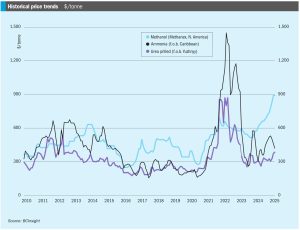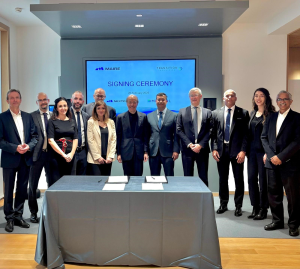
Nitrogen+Syngas Expoconference 2025
A review of papers presented at CRU’s Nitrogen+Syngas 2025 Expoconference, held in Barcelona from February 10th-12th 2025.

A review of papers presented at CRU’s Nitrogen+Syngas 2025 Expoconference, held in Barcelona from February 10th-12th 2025.

Liquid Wind has announced the development of a new 100,000 t/a green methanol project in Örnsköldsvik, Sweden, in collaboration with local energy company Övik Energi. Övik Energi’s combined heat and power plant in Örnsköldsvik was due to be the site of Ørsted’s FlagshipONE project, which was slated to produce 55,000 t/a of green methanol from 2025. A final investment decision (FID) was made in late 2022 when Ørsted bought out Liquid Wind’s 55% stake in the project, but the Danish offshore wind company chose to discontinue FlagshipONE in August 2024.

UAE-based chemicals and transition fuels hub TA’ZIZ has awarded an engineering, procurement, and construction (EPC) contract worth $1.7 billion to engineering company Samsung E&A to build the UAE’s first methanol plant. The facility will be located at the Al Ruwais Industrial City in the western part of the emirate of Abu Dhabi. It is projected to produce 1.8 million t/a green methanol, powered by clean energy from the grid, with the plant scheduled for completion in 2028.

The partners in the HyLion network are planning to produce low carbon hydrogen from renewable energy in Scotland and convert it into methanol for use as a low carbon fuel in the shipping, aviation, and motorsport sectors in the UK and Europe. The HyLion project partners include ARUP, McPhy Energy, Bosch, E.On, CO2 Recovery Ltd, Mareneco Ltd, Cadeler A/S, and P1 Fuels. Management and IT consultancy MHP is providing strategic and operational advice on the development and digitalisation of an efficient supply chain. Around 9,000 t/a of hydrogen and around 45,000 t/a of green methanol are planned in the initial pilot plant, which will use 63,000 t/a of biogenic CO2 from E.On’s biomass power plant at Lockerbie and from local whisky distilleries for the production of methanol. Hydrogen will come from an 80 MW electrolyser supplied by McPhy Energy, using local wind energy, with pure water being supplied using Bosch technology. P1 Fuels’ technology will convert e-methanol into an e-fuel that fits seamlessly into the existing fuel infrastructure and offers a decarbonisation solution for the automotive industry, international and national racing series, and light aircraft, for example. Another customer for the e-methanol will be the shipping company Cadeler A/S. The plant is expected to start production at the beginning of 2028.

Energy company Mabanaft says that it plans to convert four of its tanks at the Blumensand tank terminal in the Port of Hamburg over the next two years. The company’s aim is to facilitate the import of low-carbon methanol to northern Germany. Mabanaft expects demand for low carbon methanol to grow in future, both in the shipping and other transport sectors, as well as in the chemical industry.

Repsol has approved a historic €800 million investment in Ecoplanta, a pioneering project in Europe to transform urban waste into renewable fuels and circular products, adding a solution for reducing CO2 emissions in the transport sector, while at the same time promoting the circular economy. Located in Tarragona, the facility will be the first in Europe to produce methanol from municipal waste via a gasification process developed by Enerkem - a technology company in which Repsol is a partner – using waste that would otherwise end up in landfills or be incinerated.

• Prices look set to come under further pressure moving into March, particularly east of Suez. Prices in the West – specifically in northwest Europe – have enjoyed a partial degree of support through February, though this appears unlikely to hold for much longer.

Maire Group subsidiary MET Development, together with Eni and utility company Iren Ambiente, have started the permitting process for a renewable methanol and hydrogen plant at Eni’s refinery in Sannazzaro de’ Burgondi near Pavia. The plant will be developed using NextChem’s NX Circular™ technology, which allows the plant to convert waste by generating syngas, which is subsequently used to produce high quality sustainable fuels and chemicals. Once completed, the plant will be able to convert approximately 200,000 t/a of non-recyclable waste supplied by Iren’s waste management unit Iren Ambiente into synthesis gas. This will in turn be converted to produce up to 110,000 t/a of renewable methanol, as a potential fuel for decarbonisation of the maritime sector. It will also produce up to 1,500 t/a of hydrogen, which could be used in refinery processes, reducing CO2 emissions compared to fossil-generated hydrogen, or, alternatively, for sustainable mobility in road and rail transport. The plant will also recover 33,000 t/a of inert granulate, which can be used for the cement industry. The plant will use infrastructure and services already available at the refinery to optimise costs.

NEXTCHEM (MAIRE) AWARDED A LICENSING CONTRACT BY TRANSITION INDUSTRIES FOR A 2.1 MILLION TONS PER YEAR ULTRA-LOW CARBON METHANOL PLANT IN MEXICO BASED ON ITS PROPRIETARY NX ADWINMETHANOL® ZERO TECHNOLOGY NEXTCHEM’s proprietary NX AdWinMethanol® Zero offers an innovative process combining cutting-edge solutions to minimize carbon emissions, thanks to its autothermal reforming (ATR) technology The plant […]

Days 2 and 3 of the CRU’s 38th Nitrogen+Syngas 2025 Expoconference turned to the technical sessions, organised in three parallel streams covering: green ammonia technology, nitric acid and ammonium nitrate, plant operations and reliability, urea technology, digitalisation, carbon capture, emissions reduction and sustainable fertilizer production, and fertilizer finishing.